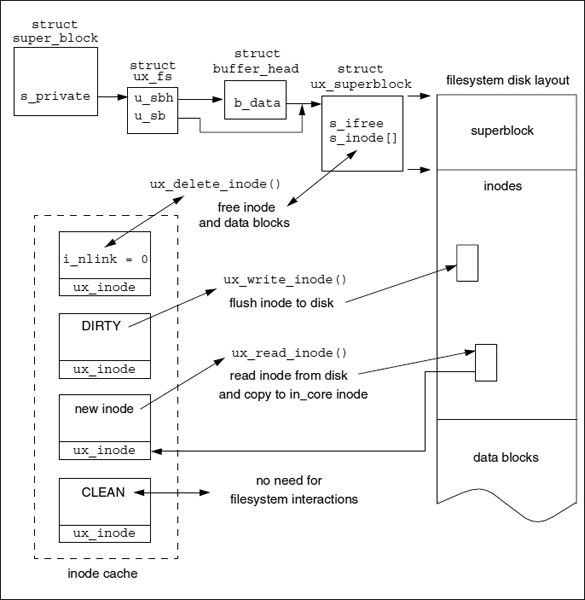Inode Manipulation
Previous sections have already highlighted some of the interactions between the kernel, the inode cache, and the filesystem. When a lookup request is made into the filesystem, uxfs locates the inode number and then calls iget() to read the inode into memory. The following sections describe the inode cache/filesystem interactions in more detail. Figure 14.6 can be consulted for a high-level view of these interactions.
Reading an Inode from Disk
The ux_read_inode() function (lines 1061 to 1109) is called from the kernel iget() function to read an inode into memory. This is typically called as a result of the kernel calling ux_lookup(). A partially initialized inode structure is passed to ux_read_inode() as follows:
void ux_read_inode(struct inode *inode)

Figure 14.6 Kernel/filesystem interactions when dealing with inodes.
and the inode number of the inode can be found in inode->i_ino. The role of ux_read_inode() is simply to read the inode into memory and copy relevant fields of the disk portion of the disk-based inode into the inode structure passed.
This is a relatively straightforward task in uxfs. The inode number must be converted into a block number within the filesystem and then read through the buffer cache into memory. This is achieved as follows:
block = UX_INODE_BLOCK + ino; bh = sb_bread(inode->i_sb, block)
Recall that each uxfs inode is held in ...
Get UNIX Filesystems: Evolution, Design, and Implementation now with the O’Reilly learning platform.
O’Reilly members experience books, live events, courses curated by job role, and more from O’Reilly and nearly 200 top publishers.

